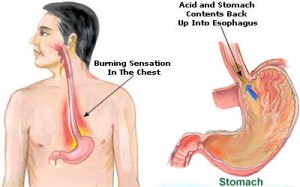 In present days a lot of people have the problem of Hyperacidity. Excessive gastric juice activity results in acidic or sour taste in the mouth. So here is the Ayurvedic solution for the Hyperacidity problem.
In present days a lot of people have the problem of Hyperacidity. Excessive gastric juice activity results in acidic or sour taste in the mouth. So here is the Ayurvedic solution for the Hyperacidity problem.
Causes:
Vata: A variable digestion cannot always digest foods. When food is not digested, ama develops. These undigested food toxins begin to ferment, causing burning sensations.
Pitta: Eating too many hot, spicy, sour, greasy foods and spices (e.g., onions, garlic, red peppers); incompatible foods, alcohol, and overeating. Other causes include eating too many sweets, such as cakes, which ferment and produce acid in the stomach.
Kapha: Weak digestion allows ama to develop when food is not digested. Thus, toxins ferment and cause burning sensations.
Symptoms:
Heartburn, belching with sour taste or fluids, nausea, vomiting.
Therapies:
Vata: Hingwastak, rock salt, lashunadi vati, draakshya, along with antacids like sankha bhasma, avipattikar churna , fennel, and praval pishti.
Pitta: Pitta-reducing foods and herbs, antacid foods like milk and ghee. Acidic and sour foods are avoided, including bananas (sour post-digestive taste), pickles, wine, and yogurt. Useful herbs include shatavarí, licorice, aloe gel, chiraayata, and antacids like shankha bhasma (conch shell ash) and avipattikar churna.
Kapha: Hingwastak, rock salt, lashunadi bati, draksha; and antacids like sankha bhasma (conch shell ash) and avipattikar churna.
1 thought on “Hyperacidity treatment in Ayurveda”
Comments are closed.